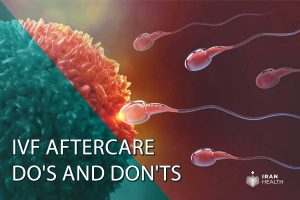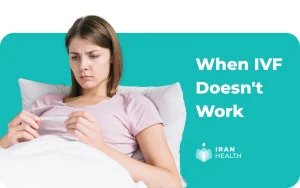Important Note:
IranHealthAgency delves into how genetics work in IVF. Couples contemplating IVF in Iran can confidently maintain their genetic connections, just as they would in a natural conception.
How do genetics work in IVF?
Let’s start with the basics. In vitro fertilization, or IVF, is a process that involves mixing eggs and sperm outside the body in a lab. Genetics is key here. After conception, the baby inherits DNA from both the egg and the sperm, which is crucial in determining the baby’s traits and body characteristics.
How IVF Changes the Game
In a normal pregnancy, the genetic material comes from both the egg of the mother and the sperm of the father. However, IVF gives parents more choices that can change the child’s genes:
-
Using Donor Eggs or Sperm
Genetics are changed when gift eggs or sperm are used. The baby will have genetics similar to the giver and the parent who gave the egg or sperm. For example, if an egg donor is used, the baby will get genes from the egg donor and the person who provided the sperm. Genetics is complicated, and external factors can change how genes are expressed. Therefore, it means that the baby might not genetically look like the intended mother (if her egg wasn’t used), but it might look like the non-genetic parent.
-
Surrogacy:
Surrogate mothers are women who carry babies for other people who are not able to have a pregnancy themselves. The baby is made from the egg and sperm of the intended parents, not the surrogate mother. This means that the surrogate mother is not biologically related to the baby she is carrying.
-
Reimplantation genetic testing (PGT):
Preimplantation genetic testing (PGT) can tell you if the baby has any genetic diseases or chromosomal problems before you put it in. Thus, you may be less likely to pass on some DNA diseases.
Using PGT to choose which embryos to keep is a powerful tool, but it also brings up ethical questions about DNA selection and “designer babies.” As IVF technology keeps getting better, it will be very important for people who want to have children to understand the genetic effects.
Physical Resemblance
Your physical traits, such as height, eye color, and hair type, are influenced by the genes you receive from your biological parents(original parents).
When a couple decides to have a baby through in vitro fertilization (IVF), the genetic material from both parents is used to create the embryo. Therefore, this increases the chances of the child having the physical features of both parents.
However, sometimes, a donor’s genetic material is used, which means the child might also inherit some characteristics from the donor.
What Are the Chances of IVF Babies Looking Like Mom or Dad?
To give you a sense of how likely it is for a child born from IVF to inherit specific traits from each parent, here are some statistics:
| Eye Color | Inheritance Pattern | The Chances of Inheritance |
| Blue | Autosomal dominant | 50-70% chance of inheriting from one parent |
| Brown | Autosomal dominant | 70-80% chance of inheriting from one parent |
| Green | Autosomal recessive | 20-30% chance of inheriting from one parent |
| Hazel | Combination of genes | 30-50% chance of inheriting from one parent |
| Hair Color | Inheritance Pattern | The Chances of Inheritance |
| Blonde | Autosomal recessive | 20-30% chance of inheriting from one parent |
| Brown | Autosomal dominant | 70-80% chance of inheriting from one parent |
| Red | Autosomal recessive | 10-20% chance of inheriting from one parent |
| Black | Autosomal dominant | 80-90% chance of inheriting from one parent |
| Facial Feature | Inheritance Pattern | The Chances of Inheritance |
| Nose shape | Polygenic | 50-70% chance of inheriting from one parent |
| Face shape | Polygenic | 50-70% chance of inheriting from one parent |
| Lip shape | Autosomal dominant | 70-80% chance of inheriting from one parent |
| Ear shape | Autosomal recessive | 20-30% chance of inheriting from one parent |
Note of importance:
These numbers and real-life examples show how different IVF kids can look. Genomics follows a pattern, but each parent’s genes and chance events during pregnancy and development can cause a child to have a wide range of physical traits.
Note that these numbers are based on information about the whole group and may not apply to you. Stay focused on the fact that your IVF baby is a unique person, and how they look is just one part of that.
The Emotional Ups and Downs of IVF Parenthood
The genetic and physical features of IVF babies’ looks are important, but the emotional impact on their parents is equally significant. Many IVF parents express a desire for their children to resemble them, as it fosters a sense of connection and belonging.
Statements from Real People
Let’s explain our words by the real testimonial we heard from our patients
Personal Testimonials
As healthcare providers, we’ve seen many couples struggle with infertility, and each story is unique. But one couple’s journey stands out; we’re honored to share it with you.
This couple came to us seeking help to build their family. The husband had been married before and had two children from his previous marriage. However, he had undergone a vasectomy, making it impossible for him and his current partner to conceive naturally.
Despite this challenge, the couple was determined to have a child together. They explored their options and decided to pursue IVF with sperm donation.
“The decision about sperm donation wasn’t easy. We wanted a healthy child with some of our physical traits. But the idea of a stranger felt isolating.”
But here’s where their story takes an extraordinary turn.
The husband’s son from his previous marriage, now a young adult, offered to be their sperm donor. This meant that their future child would have a biological connection to the husband’s family, and they would be able to build a family together.
We worked closely with the couple to navigate the IVF process, and after months of waiting, they received the news they had been hoping for: the wife was pregnant!
As the wife carried their baby, we knew they would eventually need to talk with their child about their unique family dynamics. We encouraged them to be open and honest with their child (really, do we have to be honest about the situation?) and to prepare for any questions or emotions.
“We were worried about how our daughter would react to the news,” the wife said in a recent interview. “But she’s been so understanding and loving. She’s proud to have a big brother who helped bring her into the world.“
Let’s hear about the other two simple story:
When we used my husband’s sperm and a donor egg, I was worried our baby wouldn’t look like either of us. But when she was born, I was amazed to see my nose and chin on her little face. It was such a special moment that helped me bond with her immediately,” shares Sarah, an IVF mother.
In contrast, another parent recalls feeling disappointed that her son favored the egg donor more than she did. “I had to remind myself that genetics aren’t everything. As I watched him grow, I saw so much of my husband’s personality in him, and that’s what matters.”
Words of Comfort
IVF parents should keep in mind that how their child looks is only one part of their relationship with them. Ultimately, the love you share, the memories you make, and the emotional and social bonds you make will be much more important than how much you look alike.
If worries about the way your IVF baby looks are making you feel bad talk to your fertility clinic, a support group, or a mental health worker. They can give you good advice and help you deal with the complicated feelings that may arise.
In the end, the most important factors are your child’s health and your ability to form a loving, satisfying bond with them. If you are patient, understanding, and focused on the deeper bonds you’ll share, you can make your IVF baby’s looks a particular part of their identity.



